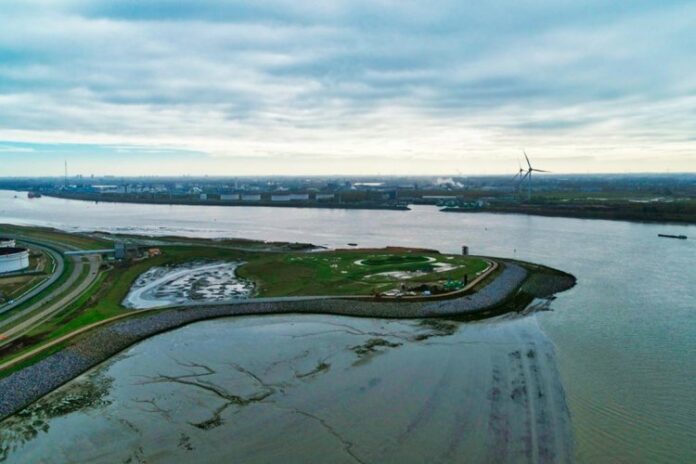The redevelopment of the site around Fort Sint-Filips on the right bank of the Scheldt has been completed after two years.
After dealing with the pollution on the site, a dike and a new, higher water barrier were built to protect the city and the business parks at the port against high water levels from the Scheldt, in an initiative from De Vlaamse Waterweg NV and Port of Antwerp. A pipeline strip was also provided. The transformation of the site is part of the Sigma Plan, which aims to restore riverine nature in addition to flood protection. This is provided by the new dam in the Scheldt downstream of the fort, which encourages the development of tidal nature.
The transformation of the site of the 19th-century Fort Sint-Filips on the right bank of the Scheldt has been completed. The works lasted over 2 years and were carried out by Jan De Nul, Envisan, DEME Environmental and partners as the contractor. They are part of the Flemish government’s Sigma Plan to protect Antwerp and the port area around the fort from flooding from the Scheldt and to restore rare riverine nature. This was why a dike and a flood wall were constructed around the site, suitable for coping with the future effects of climate change. To carry out these works, the historically contaminated site was sanitised.
A low stone dam was constructed in the Scheldt itself, just beyond the fort. This tidal dam is perpendicular to the direction of flow and locally slows the flow of water. This means that mudflats and salt marshes, which are created by the play of ebb and flow and are important for biodiversity in and around the Scheldt, are less likely to be washed away. That could create a 20-hectare zone of valuable tidal nature.
For the construction of the dam, dredged material previously deposited on the site was reused, so no new soil had to be brought in. The project received European support for this through the Smartsediment initiative. This supports the North Sea estuaries in large-scale maintenance works to create a sustainable estuary.
Lydia Peeters, Flemish Minister of Mobility and Public Works:
“The works at Fort Sint-Filips are just one part of the large-scale dyke works that we are carrying out in different areas of the port along the Scheldelaan as part of the Sigma Plan. Given the scale of this transformation, this is one of the largest ever in Flanders.”
Annick De Ridder, Vice-Mayor city of Antwerp & President Port of Antwerp:
“Thanks to this transformation, Fort Sint-Filips is once again in top condition to protect Antwerp and the port. Thanks to the dike and the flood wall, the business parks at the port are now better armed against potential high water levels from the Scheldt. Moreover, we are also creating a valuable nature reserve this way, which will contribute to the oxygen content of our lifeline, the Scheldt.”
Jacques Vandermeiren, CEO at Port of Antwerp:
“In our mission ‘Home port as a lever for a sustainable future’, climate resilience is essential. This project demonstrates how we can combine this ambition with care for the environment and nature. No efforts were spared to transform a historic black spot in terms of soil contamination into an area with a valuable nature reserve. In addition, there will be space for future transmission lines and sustainable development of the port.”



